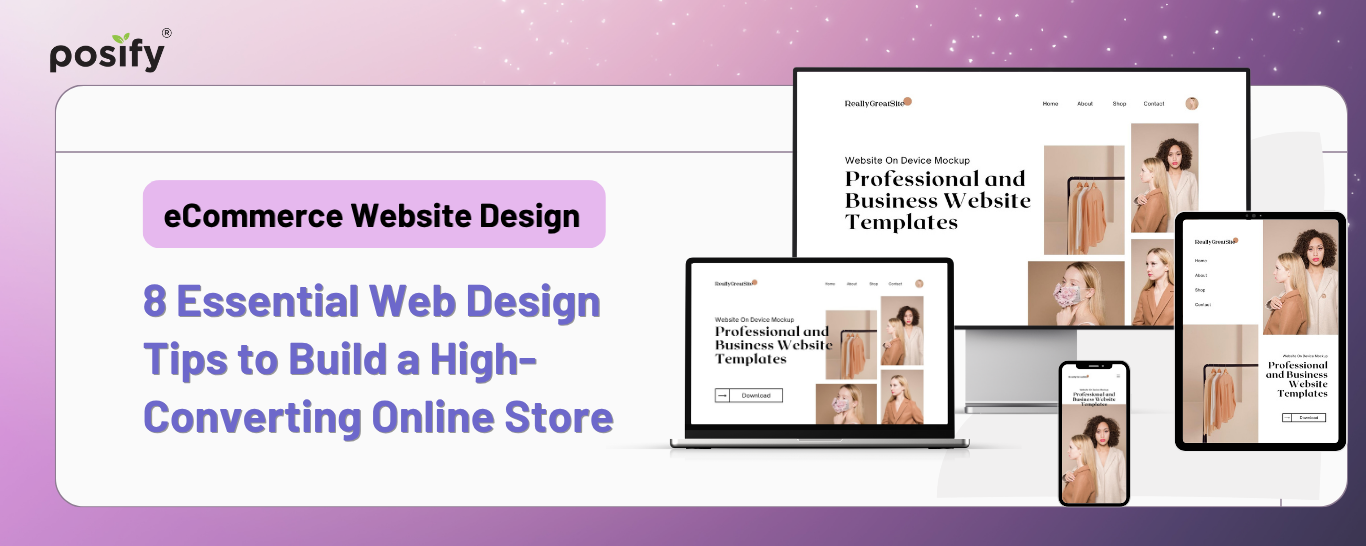8 Essential Web Design Tips to Build a High-Converting Online Store

1. Keep Your Branding Consistent and Visually Cohesive
Branding is more than just a logo—it’s the entire personality of your business as perceived by your customers. When it comes to ecommerce, maintaining a consistent visual identity across your entire website isn’t just a design choice—it’s a trust-building strategy. Shoppers should be able to instantly recognize your brand, whether they’re on the homepage, a product page, or the checkout screen.
This consistency means using your brand’s color palette, typography, logo placement, and tone of voice uniformly across every touchpoint. If your brand is sleek and high-end, your site should reflect that through elegant layouts, minimalistic visuals, and professional product photography. If your brand is youthful and bold, bright colors and playful fonts might be more appropriate. Inconsistent branding can make a store look unprofessional or even untrustworthy—two things that are conversion killers. A strong brand presence fosters recognition, builds emotional connections, and encourages return visits.
2. Simplify Your Navigation for a Frictionless User Experience
No matter how beautiful your website is, if customers can’t find what they’re looking for quickly, they’ll bounce—and they likely won’t come back. An intuitive navigation system is essential to reduce friction and help users move effortlessly through your online store.
Your top menu should be clearly structured, with straightforward category labels like “Women’s Apparel,” “Men’s Collection,” “New Arrivals,” or “Sale.” Avoid overwhelming users with too many subcategories or ambiguous names. Implement a robust search function that lets customers find products using keywords, filters, or SKU numbers. Especially in large online stores, a clean layout paired with powerful search capabilities can drastically improve retention and reduce bounce rates. Think of it this way: a well-organized site helps guide your visitors smoothly from browsing to buying.
3. Use High-Quality Product Images That Tell a Story
In ecommerce, visuals sell. Shoppers can’t touch, try on, or physically inspect your product—so your product photography needs to do the heavy lifting. High-resolution, professionally shot images build credibility and help shoppers imagine your product in their lives. At a minimum, show multiple angles of each product. For clothing, include front, back, and side views; for home items, showcase the product in a styled setting.
If your products have intricate details or textures, make sure to include a zoom-in feature. Even better, consider adding lifestyle imagery or short product demo videos to show the item in action. These aren’t just nice extras—they significantly influence buying decisions. When customers can clearly visualize what they’re purchasing, they feel more confident and are less likely to hesitate or abandon their cart.
4. Make Sure Your Website Is Mobile-Responsive
Mobile-first isn’t just a trend—it’s a necessity. In North America, more than half of all ecommerce traffic comes from mobile devices. If your website doesn’t function properly on smartphones or tablets, you’re missing out on sales. Responsive design ensures that your website adapts seamlessly to different screen sizes, offering a consistent and user-friendly experience regardless of the device.
This means fonts should be readable on smaller screens, buttons must be easy to tap, and checkout forms shouldn’t be a nightmare to fill out on mobile. A frustrating mobile experience is one of the quickest ways to lose potential customers. Test your site on multiple devices and browsers to ensure that it looks and works great everywhere. Your mobile site should never feel like a downgraded version of your desktop site—it should feel just as polished and complete.
5. Speed Matters: Optimize Your Site’s Loading Time
Consumers are impatient—especially online. If your website takes more than a few seconds to load, users will bounce. In fact, studies show that even a one-second delay in load time can reduce conversions by up to 7%. That’s why site speed isn’t just about performance—it directly impacts your bottom line.
Start by compressing large image files without sacrificing quality. Clean up your code by removing unused scripts or third-party apps you no longer need. Use caching and consider switching to a faster web host or implementing a content delivery network (CDN) to serve your content efficiently across geographic locations. Bonus: improving site speed also boosts your SEO, helping you rank higher on search engines. Fast sites feel professional, trustworthy, and frictionless—everything an online shopper wants.
6. Ensure a Secure and Transparent Checkout Process
Trust is everything in ecommerce. Shoppers are putting their personal and payment information into your hands, and if there’s even a hint of insecurity, they’ll abandon their carts. The very first step is making sure your site is encrypted with an SSL certificate (your URL should start with “https”). This small change makes a big difference in how safe your site feels.
Next, offer secure, reliable payment gateways that customers recognize and trust—like Stripe, PayPal, or Apple Pay. If you’re selling in a specific region like Canada or the U.S., you may also want to include local payment methods to reduce friction. Always include clearly written return policies and privacy statements. Transparency during checkout reassures shoppers and helps reduce hesitation. The more frictionless and secure your checkout flow is, the higher your conversion rate will be.
7. Use Clear and Compelling Calls-to-Action (CTAs)
Designing a beautiful site is one thing—but prompting users to act is what drives results. Strategic placement of calls-to-action (CTAs) is key to moving your customers down the sales funnel. Phrases like “Add to Cart,” “Shop Now,” “Get 20% Off Today,” or “See More” may seem simple, but they’re essential to driving engagement.
CTAs should stand out visually using bold colors or contrasting shapes that draw attention. Place them near product images, at the top of your homepage, or within promotional banners. You can also use psychological triggers like urgency or scarcity—“Only 3 left in stock” or “Limited-Time Offer” are powerful motivators. The goal is to guide users naturally toward the next step in their journey, without overwhelming them with too many choices.
8. Showcase Customer Reviews and Social Proof
Today’s consumers trust other customers more than they trust advertising. That’s why social proof—real testimonials, ratings, and user-generated content—is crucial to establishing trust and credibility. Display reviews directly on product pages, including star ratings and written feedback. If possible, highlight customer photos or social media mentions to bring a human touch to your store.
You can also feature selected Instagram posts where customers have tagged your product, or show follower counts from platforms like Facebook or TikTok to build credibility. This not only reassures new customers but also adds community energy to your brand. You’re not just selling a product—you’re inviting people to join your brand story.
Key Features: Why Choose Posify?
1️⃣ Free E-Commerce Platform for a Hassle-Free Start
- Posify offers a zero-barrier free platform, allowing small businesses to quickly launch their online store.
- Save on setup costs and reinvest in products and marketing for higher returns.
2️⃣ Professional Store Design to Elevate Your Brand
- Choose from diverse ready-made templates tailored to various industries, ensuring your store looks professional and functions seamlessly.
- Supports custom designs, enabling you to create a unique store that enhances brand appeal.
3️⃣ SEO Optimization Services to Boost Search Engine Visibility
- Built-in SEO tools help your products rank higher on Google search results, attracting more potential customers.
- Offers data analytics to understand visitor behavior and continuously optimize performance.
4️⃣ Smooth Shopping Experience to Increase Conversion Rates
- Features like fast checkout and smart search make shopping convenient, encouraging purchases.
- Supports multiple languages and currencies, helping you expand into international markets.
5️⃣ Comprehensive Data Support for Precision Marketing
- Provides real-time data reports to help you track sales dynamics, customer behavior, and inventory status, enabling data-driven decisions.
- Supports member points systems and promotional campaign designs to enhance customer loyalty.
Conclusion: Posify Makes Your Online Store Stand Out!
Launching an online store has never been easier! Whether you’re a startup or a physical store owner, Posify provides professional and efficient solutions to help you enter the online market effortlessly. Join Posify today and build a unique online store that makes your brand shine in a competitive market!





